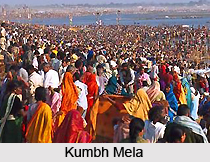 In the ancient years, Haridwar came to be known as Mayapuri, Gangadwar and Tapovan. This sacred place is a place of pilgrimage from time immemorial. Haridwar is among the four places where once after every twelve years Kumbh mela is celebrated. According to the Hindu mythology, Haridwar is the holy spot where Amrit (nectar), the drink of gods that grants immortality fell.
In the ancient years, Haridwar came to be known as Mayapuri, Gangadwar and Tapovan. This sacred place is a place of pilgrimage from time immemorial. Haridwar is among the four places where once after every twelve years Kumbh mela is celebrated. According to the Hindu mythology, Haridwar is the holy spot where Amrit (nectar), the drink of gods that grants immortality fell.
Origin of sacred practice of Kumbh Mela is probably as old as the time of Samudra Manthan, when the Gods and the asuras were busy in collection of Amrit (nectar). To prevent the amrit vessel from going into the hands of the asuras, the devtas handled it to the four Gods, namely Brahaspati, Surya, Chandra and Shani. After understanding the conspiracy of the Devtas, the Asuras chased the four devtas for pursuing the Amrit Kalash. This continued until twelve days and nights, in the process the Lords ran round the Earth and hided the Amrit Kalash in four different places namely Haridwar, Prayag, Ujjain and Nasik.
According to the Mythological legends, the actual fight that took place between the Lords and the Asuras, Amrit (nectar) vessel broke down and dripped at these four places. To memorialize this event, Kumbh Mela is organized after every twelve years. The four spots where nectar (Amrit) fell are today the celestial places wherein Kumbh Mela is held. Millions of pilgrims and devotees assemble together to be a part of this holy event. They perform ritualistic bathing on the banks of the River Ganga.



















